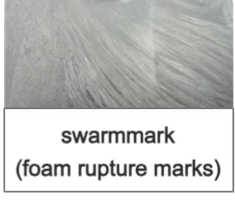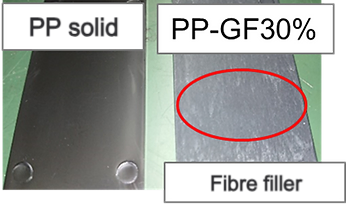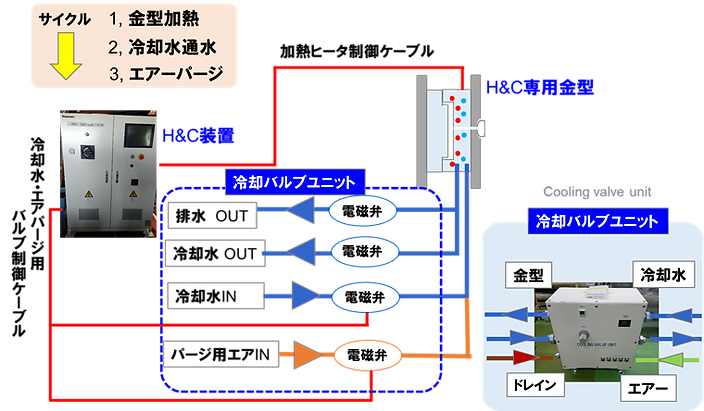Foam molding technology: high-speed heat & cool for lighter weight and higher appearance
- SANKO GOSEI
- Dec 11, 2024
- 3 min read
Background: what are the challenges of foam molding?
Foam molding is an excellent technology that can contribute to weight reduction and lower material costs in large plastic molded products such as automobiles. However, while it excels in weight reduction, it also presents challenges in terms of appearance quality. In particular, the following two problems stand out

Swirl marks: bubble-break marks that occur during foaming appear on the surface.

Floating fibre filler: fibres are exposed on the surface of glass fibre-filled materials when they are in use, which detracts from their aesthetic appearance.
These appearance defects have been an unavoidable difficulty in conventional foam molding.
For this reason, foam molded products have been considered unsuitable for appearance parts.
▸ What is Heat & Cool molding?

Heat & Cool molding is a technology that controls the mold cavity surface temperature by heating and cooling during the molding cycle. This technology is particularly effective in the production of high appearance and thin-walled products and enables quality improvements that are difficult to achieve with conventional injection molding.
New technology: what is high-speed heat & cool molding?
High-speed Heat & Cool molding is a technology that controls the mold surface temperature during the molding cycle. Specifically, the mold inner surface temperature is rapidly heated, maintained and cooled to improve the surface quality of the molded product. The key to this technology lies in the introduction of an electric heating system.

Heat & Cool system configuration

Heating, warming and cooling can be carried out in one cycle in conjunction with the molding cycle of the molding machine.
Heat & Cool mold configuration

Inside the mold : Consists of a heating heater, a warming heater and cooling piping.
▸Trial results

The material used for the prototype is PP-GF40 (Daicel Plastron)
(long fibre glass reinforced PP resin).
The prototypes were compared under four conditions: (1) Normal solid molding, (2) Heat & Cool molding, (3) Foam molding, and (4) Foam molding + Heat & Cool molding.
Images of the molded products obtained under each condition are shown below.


As a result, in the foam molding + Heat & Cool molding of (4)
Swirl mark disappearance: the high-temperature mold improves the flowability of the resin, which has the effect of burying the broken foam marks.
Disappearance of fibre filler: before the glass fibres are exposed on the mold surface, the resin is completely transferred, resulting in a beautiful finish.
This has made it possible to achieve a high appearance even with glass fibre-reinforced resins (40% PP-GF), which was previously considered difficult to achieve.
Considerations.
Why did combining Heat & Cool with foam molding have an effect on the disappearance of fibre filler and swirl marks?

Disappearance of fibre filler: In normal molding, fibres appear on the mold surface immediately after filling is completed. However, in Heat & Cool, the mold is hotter and the transferability is better, so the resin penetrates between the mold/fibres and the appearance is considered to be better.
Elimination of swirl marks: In general foam molding, air bubbles grow and burst during the process of filling the mold with resin and harden on the surface.
However, in Heat & Cool, the mold is hot, so the air bubbles do not harden immediately but flow and are less likely to appear on the surface. In addition, the cooling process solidifies the air bubbles and they become trapped inside, resulting in a good appearance.
Applications and benefits of the technology
Main applications
Automotive components: ideal for lightweight, highly insulating back doors and door panels in line with the shift to EVs.
Home appliances: e.g. TV frames where high gloss is required.
Advantages
Lightweight: material reduction through internal foaming.
High appearance: reduced fibre filler and swirl marks.
High strength: increased rigidity due to solid skin layer.
High thermal insulation: insulation effect due to foamed layers.
Future prospects.
High-speed Heat & Cool molding can be applied not only to glass fibres but also to super engineering plastics such as nylon and PEEK. Furthermore, the technology has great potential as the demand for large exterior components with high thermal insulation performance increases with the growing trend towards EVs.
Conclusion.
High-speed Heat & Cool molding overcomes the trade-off between ‘weight reduction’ and ‘appearance quality’ in foam molding. This technology is the key to the future of plastic molding.










Comments